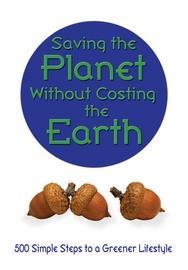As Members of CIBSE, building services engineers are bound by the code of conduct to ‘have due regard to environmental issues in carrying out their professional duties'.
If you are recommending energy efficiency and low carbon design and operation in the course of your daily work, you may well be asked what you are doing yourself in that area. Some good answers could be found in Saving the Planet Without Costing the Earth - 500 Simple Steps to a Greener Lifestyle, a book that is aimed at the individual, writes Samantha McDonough, director of policy and groups at CIBSE.
The problem with books about saving the planet - or doing anything ‘good' for that matter - is that they can adopt a preaching tone. Lets face it, we don't like to be told what to do because it usually means that we are ignorant, which is embarrassing, or that we do know what to do, but we can't be bothered, which makes us feel guilty. Thankfully, this book - written by Donnachadh (pronounced don-a-ca) McCarthy, who went through a life-changing experience in the Amazon rain forest and returned determined to do his bit to protect the environment - isn't like that. It is more of a humble testimony of what can be done by the individual - the culmination of many years' personal experience of changing a normal home into an energy efficient one.
Saving the Planet… considers personal lifestyle, domestic environments and the workplace, covering energy, water and waste, plus quirky ideas such as making arrangements for your own green funeral. Its suggestions are categorised into those that save you money; those that cost nothing; those that cost a small amount and those that require a significant capital investment.
This approach allows you to make changes straight away and plan for more in the future. A nice feature of this book is that it shows you the relative cost of changes you can make so that you can easily relate them to everyday values - "the cost of a good bottle of wine" is one that comes up frequently. Some money-saving changes may not be suitable for a family home (the frequency of toilet flushing for example), but the beauty of this book is that you can pick and choose the measures you want to take.
Explaining energy savings
As well as costing out each suggestion, McCarthy gives an idea of how much energy will be saved. Again, this is presented in easily understandable, bite-sized pieces which may at times seem a little basic for professional engineers, but make perfect sense and could be very useful when communicating these ideas with clients.
Similarly, as services engineers, many readers will think ‘I knew that already,' but among the 500 suggestions there are certainly some eye openers - for example, the natural materials that can be used for domestic cleaning and as cosmetics.
At the other end of the scale, the larger, longer-term suggestions for home improvements should be of interest to services engineers. These suggestions include green roofs, passive cooling and passive solar design. Again, many readers may have implemented these, but it is easy to find options you didn't know simply because of the long term research and practical testing put in by the author - this book has been 14 years in preparation and it shows.
One issue worth mentioning is that McCarthy's advice on grey water recycling is not entirely in tune with that in the CIBSE Knowledge Series publication on reclaimed water. This does not cover treatments for contaminated water from toilets, dish washing, clothes washing or any other source as these sources are considered unsuitable for reclamation because they are likely to be contaminated with sewage, grease, food wastes or detergents. McCarthy maintains, however, that there is no problem in throwing your dirty washing or washing up water straight on to your garden - food waste is no more dangerous than compost and some plants thrive on the phosphates contained in detergents.
In brief

Plastic fantastic
HVCA Publications has launched TR11, its guide to good practice on the use of plastic pipework in building services installations. It features a reference and checklist for the selection of suitable materials, including their engineering properties, typical applications and installation considerations.
More information 170
Light reading
Luxo has published its new Lighting for Education brochure, containing essential information for the specification of lighting in schools, colleges and universities.
More information 171
Putting the L in thermal
Guidance for achieving compliance with Part L is available from the Thermal Insulation Manufacturers and Suppliers Association. Copies can be downloaded at www.timsa.org.uk
More information 172
Employment law
CITB-ConstructionSkills has teamed up with iQ Business to launch a range of employment management packages to enable construction businesses of any size to generate the comprehensive employment documentation required by current legislation.
More information 173
Source
Building Sustainable Design
Postscript
BSj will be profiling Donnachadh McCarthy in a forthcoming issue.
Saving the Planet Without Costing the Earth - 500 Simple Steps to a Greener Life style is published by Vision Paperbacks and available from all good bookshops priced £11.99, or from the CIBSE bookshop priced £7.20 (£8.40 non-members) plus postage and packing. Visit www.cibse.org/publications or call CIBSE Publication Sales on 020 8772 3618 to order a copy.






















No comments yet